ACCT 401: Inventory Auditing, Risk Assessment & Analytical Procedures
VerifiedAdded on 2023/06/15
|7
|924
|267
Homework Assignment
AI Summary
This auditing assignment solution provides detailed insights into various aspects of auditing principles and procedures. It addresses the procedures an auditor should perform during a physical inventory count, including test counts, observation, and reconciliation. The solution also explains the inherent risk factors involved in assessing risks for intangible assets, such as changes in technology and complex accounting issues. Furthermore, it clarifies substantive analytical procedures applicable to plant, property, and equipment, emphasizing completeness and valuation. Finally, it discusses the application of analytical procedures in auditing an income statement, focusing on completeness and accuracy. Desklib offers this document along with a wide array of study resources, including past papers and solved assignments, to support students in their academic endeavors.
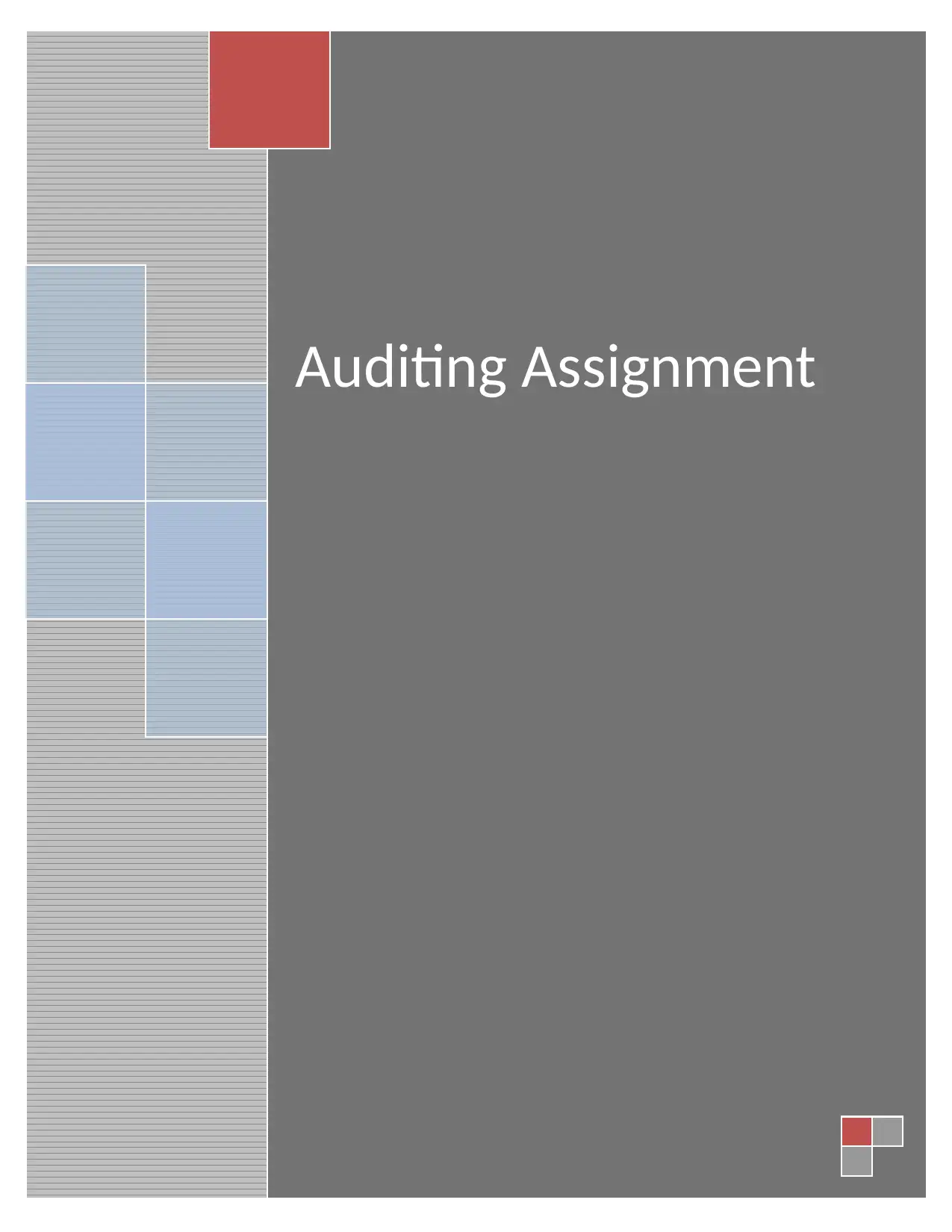
Auditing Assignment
Paraphrase This Document
Need a fresh take? Get an instant paraphrase of this document with our AI Paraphraser
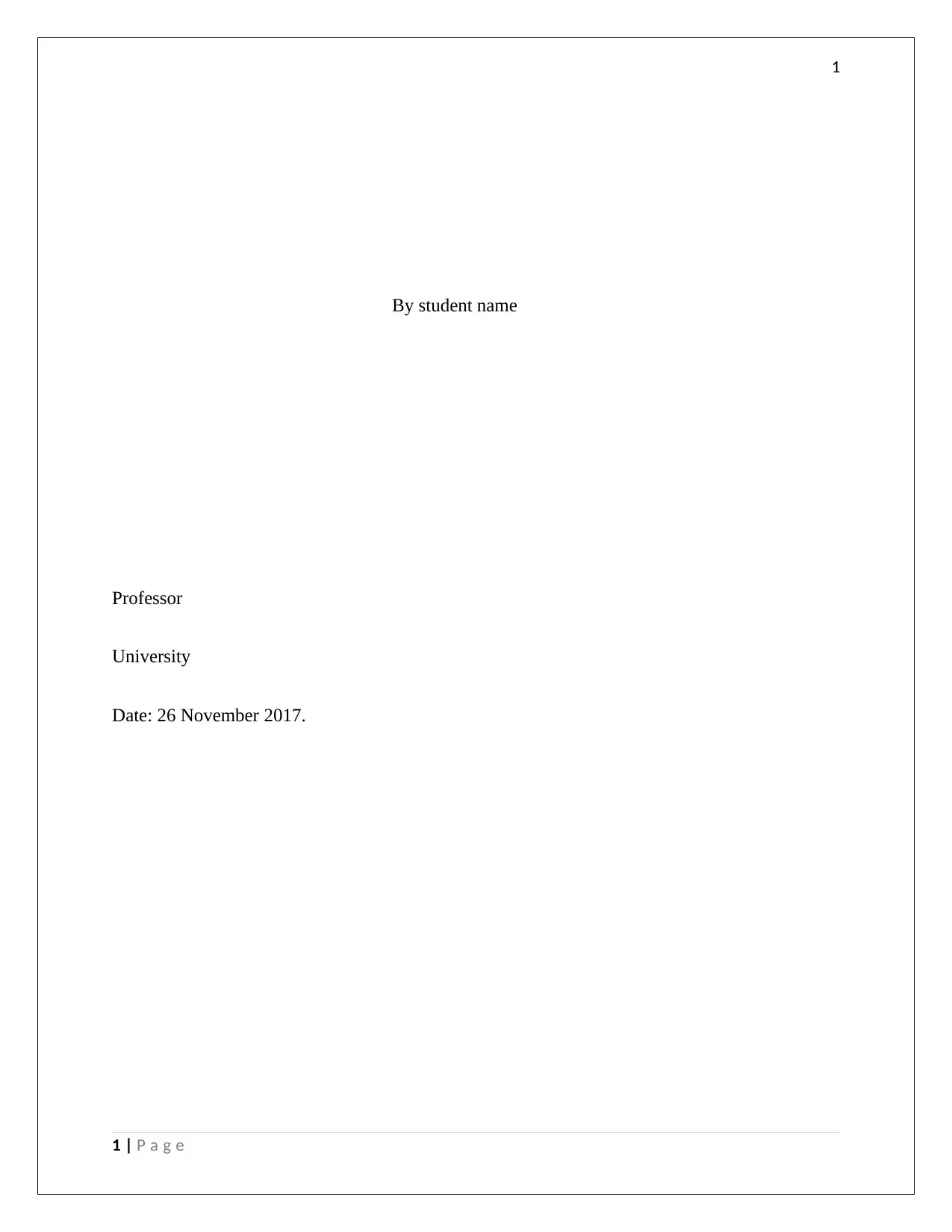
1
By student name
Professor
University
Date: 26 November 2017.
1 | P a g e
By student name
Professor
University
Date: 26 November 2017.
1 | P a g e

2
Contents
Question 1………………….....……………………….………....……..……………………………………….3
Question 2…………….…………..………………....……..………………………………………………..…..3
Question 3……………….…..………………....……..……………………………………………………….…..4
Question 4……………….…..………………....……..……………………………………………………….…..4
References………..…….…………..………………....……..……………………………………………………..6
2 | P a g e
Contents
Question 1………………….....……………………….………....……..……………………………………….3
Question 2…………….…………..………………....……..………………………………………………..…..3
Question 3……………….…..………………....……..……………………………………………………….…..4
Question 4……………….…..………………....……..……………………………………………………….…..4
References………..…….…………..………………....……..……………………………………………………..6
2 | P a g e
⊘ This is a preview!⊘
Do you want full access?
Subscribe today to unlock all pages.

Trusted by 1+ million students worldwide
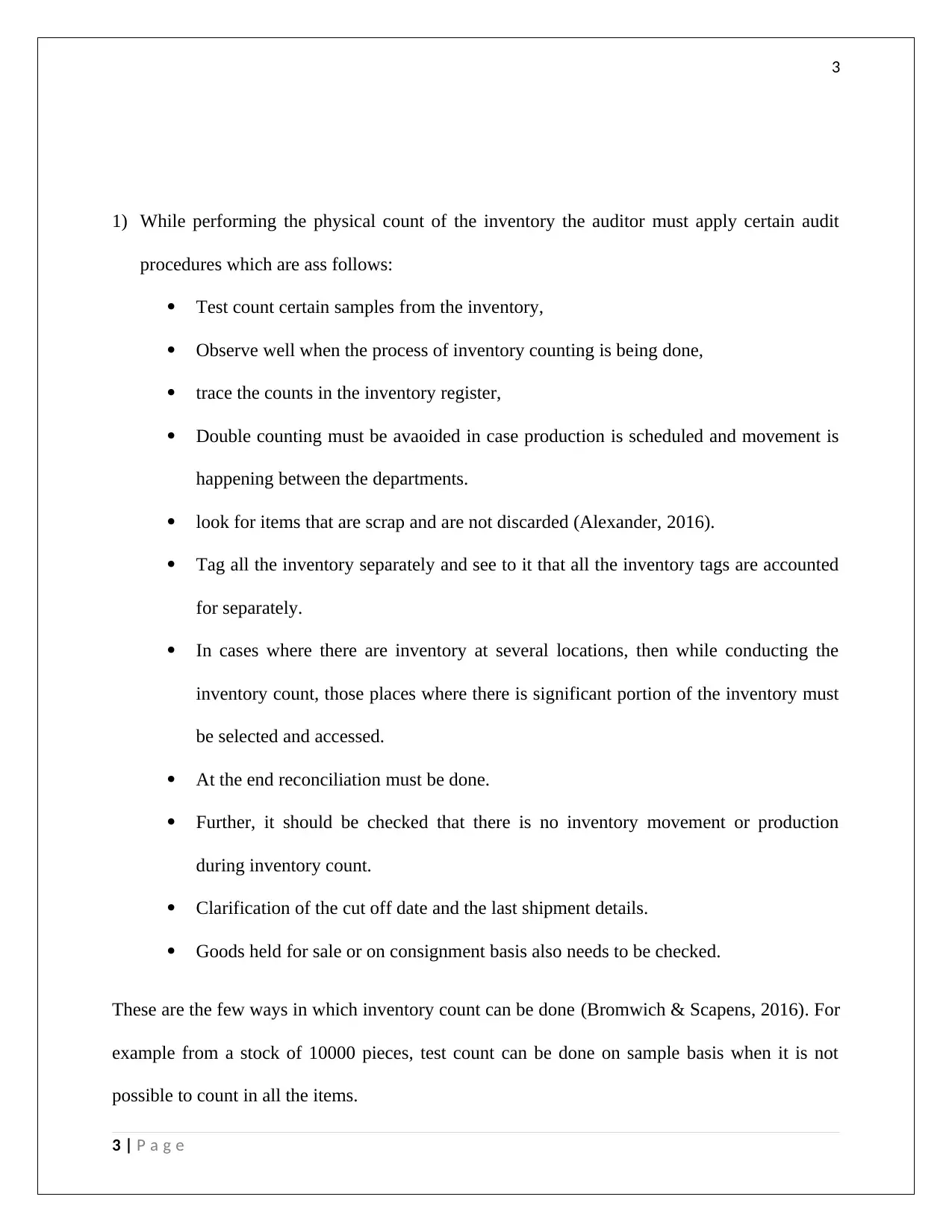
3
1) While performing the physical count of the inventory the auditor must apply certain audit
procedures which are ass follows:
Test count certain samples from the inventory,
Observe well when the process of inventory counting is being done,
trace the counts in the inventory register,
Double counting must be avaoided in case production is scheduled and movement is
happening between the departments.
look for items that are scrap and are not discarded (Alexander, 2016).
Tag all the inventory separately and see to it that all the inventory tags are accounted
for separately.
In cases where there are inventory at several locations, then while conducting the
inventory count, those places where there is significant portion of the inventory must
be selected and accessed.
At the end reconciliation must be done.
Further, it should be checked that there is no inventory movement or production
during inventory count.
Clarification of the cut off date and the last shipment details.
Goods held for sale or on consignment basis also needs to be checked.
These are the few ways in which inventory count can be done (Bromwich & Scapens, 2016). For
example from a stock of 10000 pieces, test count can be done on sample basis when it is not
possible to count in all the items.
3 | P a g e
1) While performing the physical count of the inventory the auditor must apply certain audit
procedures which are ass follows:
Test count certain samples from the inventory,
Observe well when the process of inventory counting is being done,
trace the counts in the inventory register,
Double counting must be avaoided in case production is scheduled and movement is
happening between the departments.
look for items that are scrap and are not discarded (Alexander, 2016).
Tag all the inventory separately and see to it that all the inventory tags are accounted
for separately.
In cases where there are inventory at several locations, then while conducting the
inventory count, those places where there is significant portion of the inventory must
be selected and accessed.
At the end reconciliation must be done.
Further, it should be checked that there is no inventory movement or production
during inventory count.
Clarification of the cut off date and the last shipment details.
Goods held for sale or on consignment basis also needs to be checked.
These are the few ways in which inventory count can be done (Bromwich & Scapens, 2016). For
example from a stock of 10000 pieces, test count can be done on sample basis when it is not
possible to count in all the items.
3 | P a g e
Paraphrase This Document
Need a fresh take? Get an instant paraphrase of this document with our AI Paraphraser
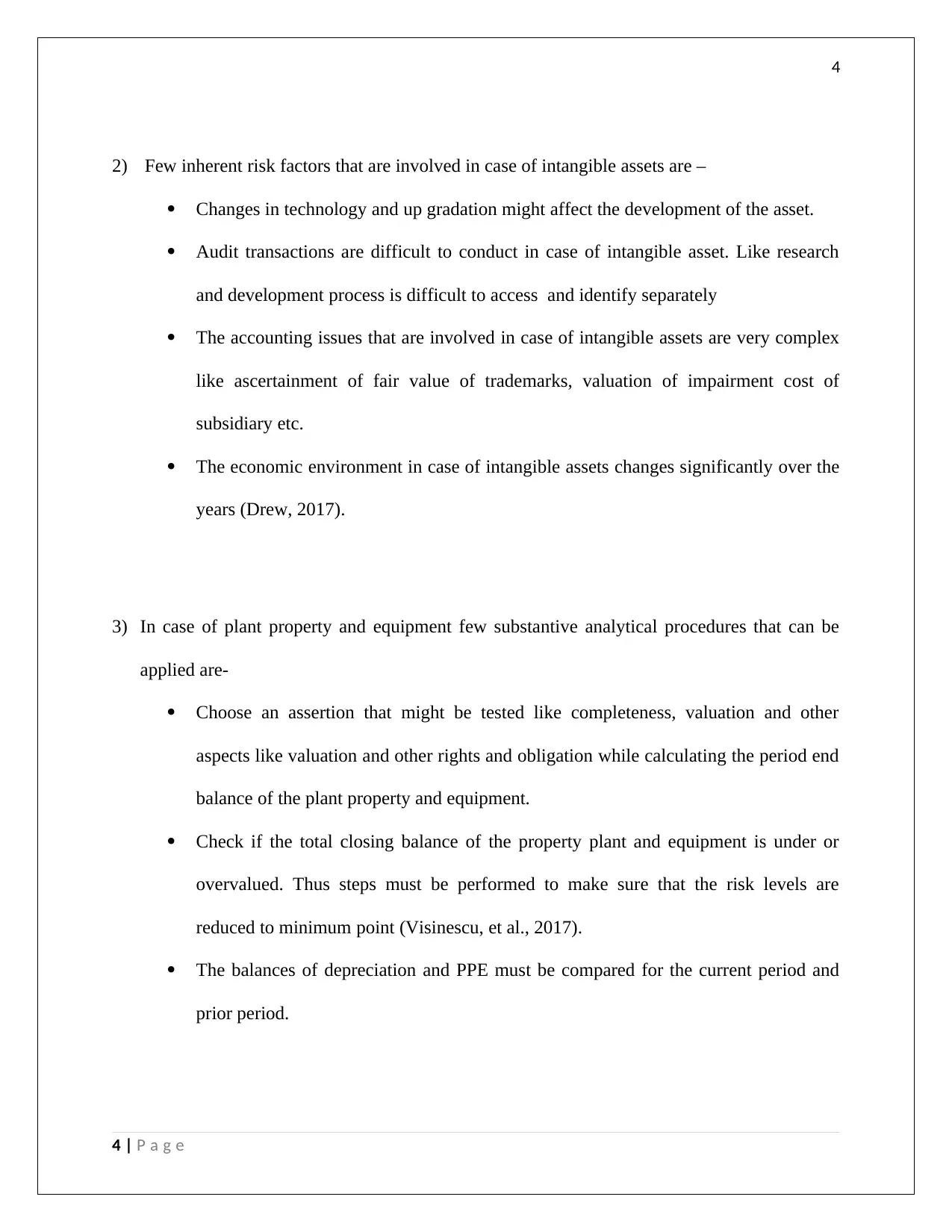
4
2) Few inherent risk factors that are involved in case of intangible assets are –
Changes in technology and up gradation might affect the development of the asset.
Audit transactions are difficult to conduct in case of intangible asset. Like research
and development process is difficult to access and identify separately
The accounting issues that are involved in case of intangible assets are very complex
like ascertainment of fair value of trademarks, valuation of impairment cost of
subsidiary etc.
The economic environment in case of intangible assets changes significantly over the
years (Drew, 2017).
3) In case of plant property and equipment few substantive analytical procedures that can be
applied are-
Choose an assertion that might be tested like completeness, valuation and other
aspects like valuation and other rights and obligation while calculating the period end
balance of the plant property and equipment.
Check if the total closing balance of the property plant and equipment is under or
overvalued. Thus steps must be performed to make sure that the risk levels are
reduced to minimum point (Visinescu, et al., 2017).
The balances of depreciation and PPE must be compared for the current period and
prior period.
4 | P a g e
2) Few inherent risk factors that are involved in case of intangible assets are –
Changes in technology and up gradation might affect the development of the asset.
Audit transactions are difficult to conduct in case of intangible asset. Like research
and development process is difficult to access and identify separately
The accounting issues that are involved in case of intangible assets are very complex
like ascertainment of fair value of trademarks, valuation of impairment cost of
subsidiary etc.
The economic environment in case of intangible assets changes significantly over the
years (Drew, 2017).
3) In case of plant property and equipment few substantive analytical procedures that can be
applied are-
Choose an assertion that might be tested like completeness, valuation and other
aspects like valuation and other rights and obligation while calculating the period end
balance of the plant property and equipment.
Check if the total closing balance of the property plant and equipment is under or
overvalued. Thus steps must be performed to make sure that the risk levels are
reduced to minimum point (Visinescu, et al., 2017).
The balances of depreciation and PPE must be compared for the current period and
prior period.
4 | P a g e
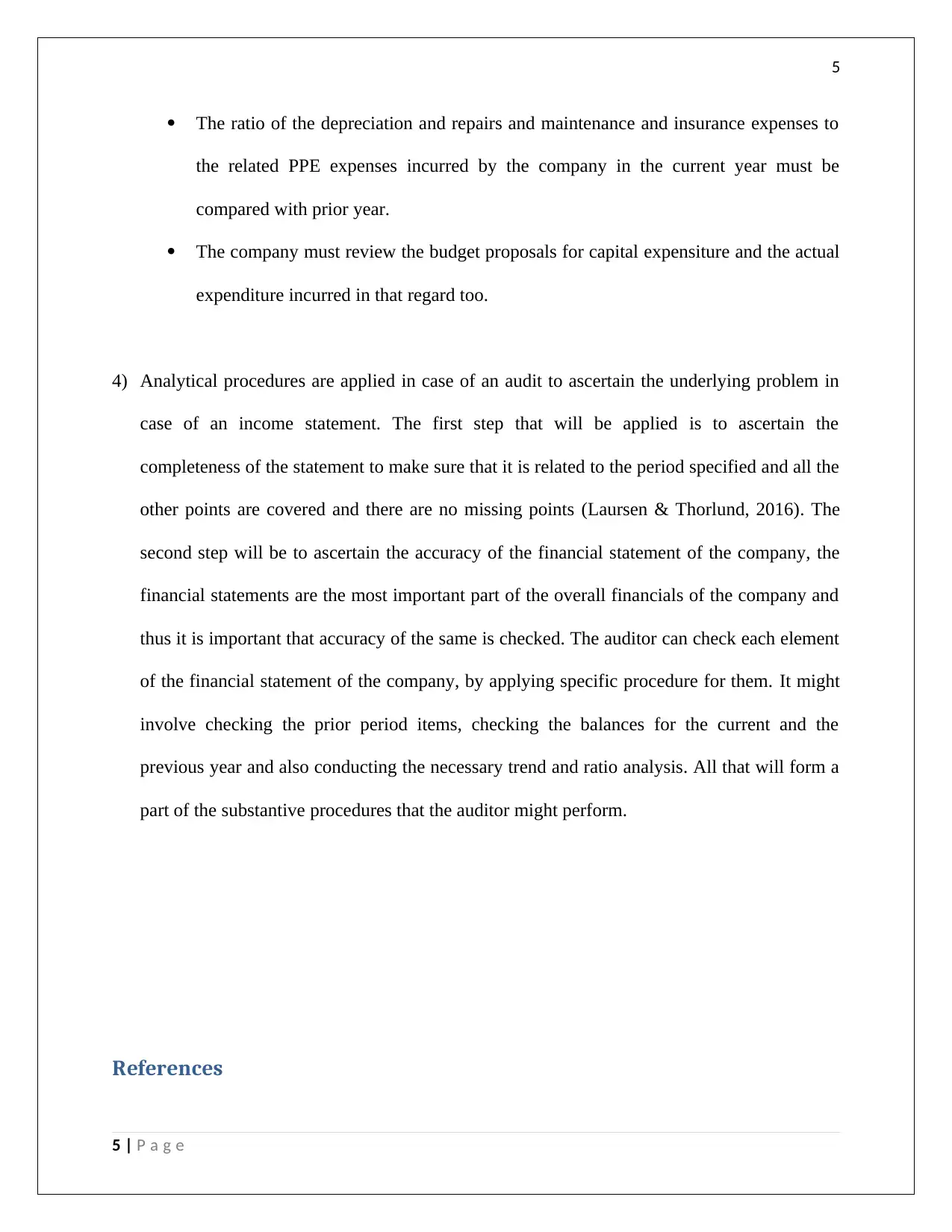
5
The ratio of the depreciation and repairs and maintenance and insurance expenses to
the related PPE expenses incurred by the company in the current year must be
compared with prior year.
The company must review the budget proposals for capital expensiture and the actual
expenditure incurred in that regard too.
4) Analytical procedures are applied in case of an audit to ascertain the underlying problem in
case of an income statement. The first step that will be applied is to ascertain the
completeness of the statement to make sure that it is related to the period specified and all the
other points are covered and there are no missing points (Laursen & Thorlund, 2016). The
second step will be to ascertain the accuracy of the financial statement of the company, the
financial statements are the most important part of the overall financials of the company and
thus it is important that accuracy of the same is checked. The auditor can check each element
of the financial statement of the company, by applying specific procedure for them. It might
involve checking the prior period items, checking the balances for the current and the
previous year and also conducting the necessary trend and ratio analysis. All that will form a
part of the substantive procedures that the auditor might perform.
References
5 | P a g e
The ratio of the depreciation and repairs and maintenance and insurance expenses to
the related PPE expenses incurred by the company in the current year must be
compared with prior year.
The company must review the budget proposals for capital expensiture and the actual
expenditure incurred in that regard too.
4) Analytical procedures are applied in case of an audit to ascertain the underlying problem in
case of an income statement. The first step that will be applied is to ascertain the
completeness of the statement to make sure that it is related to the period specified and all the
other points are covered and there are no missing points (Laursen & Thorlund, 2016). The
second step will be to ascertain the accuracy of the financial statement of the company, the
financial statements are the most important part of the overall financials of the company and
thus it is important that accuracy of the same is checked. The auditor can check each element
of the financial statement of the company, by applying specific procedure for them. It might
involve checking the prior period items, checking the balances for the current and the
previous year and also conducting the necessary trend and ratio analysis. All that will form a
part of the substantive procedures that the auditor might perform.
References
5 | P a g e
⊘ This is a preview!⊘
Do you want full access?
Subscribe today to unlock all pages.

Trusted by 1+ million students worldwide
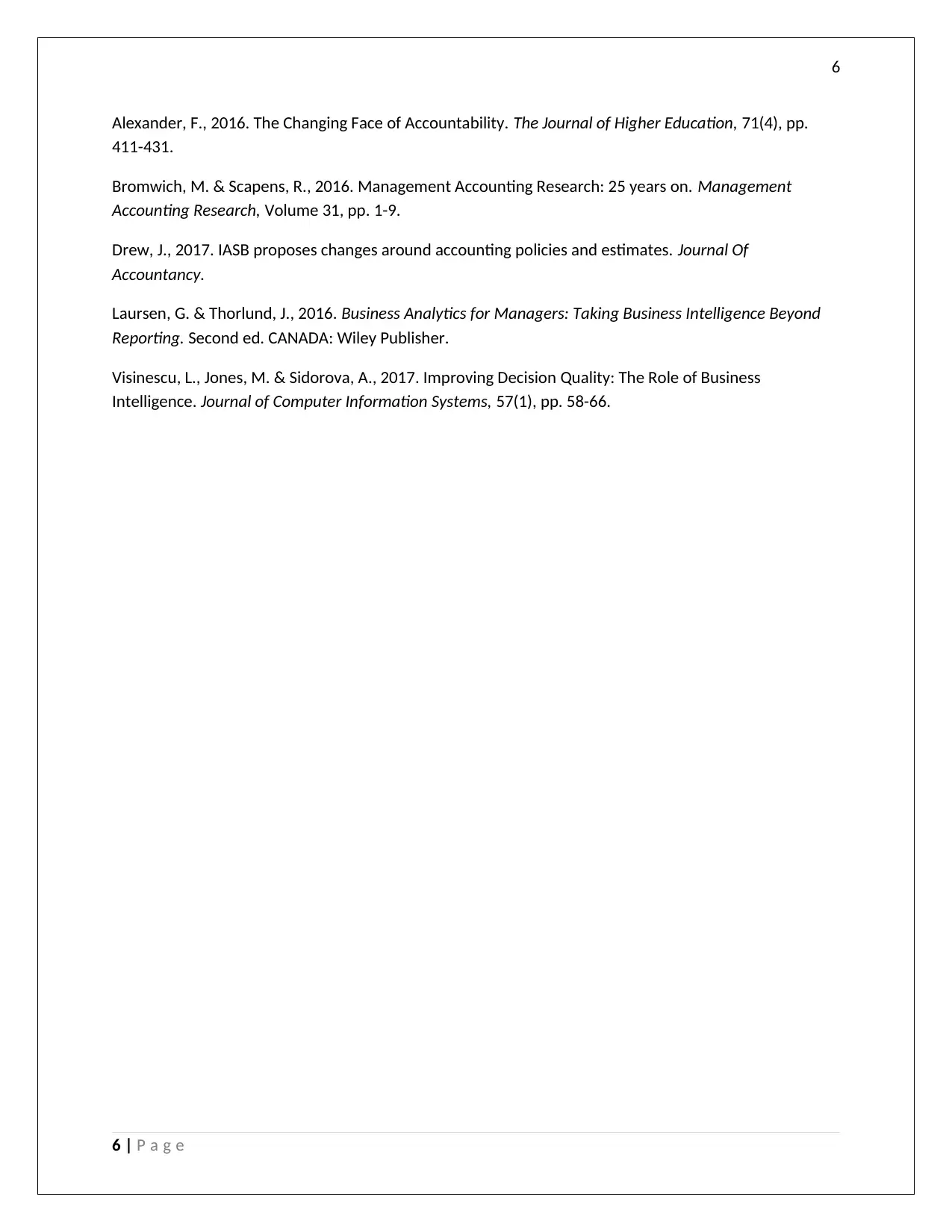
6
Alexander, F., 2016. The Changing Face of Accountability. The Journal of Higher Education, 71(4), pp.
411-431.
Bromwich, M. & Scapens, R., 2016. Management Accounting Research: 25 years on. Management
Accounting Research, Volume 31, pp. 1-9.
Drew, J., 2017. IASB proposes changes around accounting policies and estimates. Journal Of
Accountancy.
Laursen, G. & Thorlund, J., 2016. Business Analytics for Managers: Taking Business Intelligence Beyond
Reporting. Second ed. CANADA: Wiley Publisher.
Visinescu, L., Jones, M. & Sidorova, A., 2017. Improving Decision Quality: The Role of Business
Intelligence. Journal of Computer Information Systems, 57(1), pp. 58-66.
6 | P a g e
Alexander, F., 2016. The Changing Face of Accountability. The Journal of Higher Education, 71(4), pp.
411-431.
Bromwich, M. & Scapens, R., 2016. Management Accounting Research: 25 years on. Management
Accounting Research, Volume 31, pp. 1-9.
Drew, J., 2017. IASB proposes changes around accounting policies and estimates. Journal Of
Accountancy.
Laursen, G. & Thorlund, J., 2016. Business Analytics for Managers: Taking Business Intelligence Beyond
Reporting. Second ed. CANADA: Wiley Publisher.
Visinescu, L., Jones, M. & Sidorova, A., 2017. Improving Decision Quality: The Role of Business
Intelligence. Journal of Computer Information Systems, 57(1), pp. 58-66.
6 | P a g e
1 out of 7
Related Documents
Your All-in-One AI-Powered Toolkit for Academic Success.
+13062052269
info@desklib.com
Available 24*7 on WhatsApp / Email
![[object Object]](/_next/static/media/star-bottom.7253800d.svg)
Unlock your academic potential
Copyright © 2020–2025 A2Z Services. All Rights Reserved. Developed and managed by ZUCOL.




